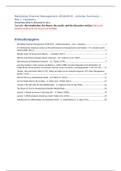Zusammenfassung
Summary Compulsory papers Marketing Channel Management: Lecture 1 t/m 8 - Marketing Management
- Kurs
- Hochschule
Compulsory papers course marketing channel management - Tilburg University Master Marketing Management. Important: these are the papers from lecture 1 - lecture 8.
[ Mehr anzeigen ]



